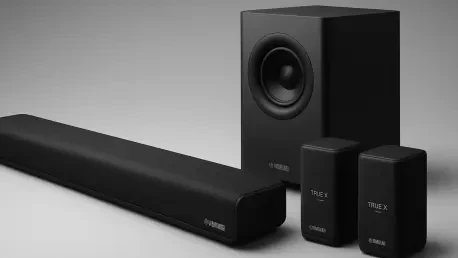Imagine stepping into your living room and being enveloped by a cinematic soundscape so immersive that every whisper, explosion, and musical note feels like it’s happening around you, a promise that cutting-edge home theater systems strive to deliver in today’s audio market where innovation drives the quest for perfection. The Yamaha True X Surround 90A, also known as the SR-X90A, has emerged as a focal point of discussion among audiophiles and tech enthusiasts. This roundup gathers diverse opinions, tips, and early impressions from various industry voices and tech communities to evaluate whether this Dolby Atmos soundbar system can truly redefine home entertainment. The aim is to provide a comprehensive look at its potential through a spectrum of perspectives.
Unpacking the Hype Around Yamaha’s Latest Audio Innovation
What Sets the True X Surround 90A Apart?
A key point of excitement across multiple tech forums centers on the unprecedented 12 up-firing drivers in the True X Surround 90A. Unlike typical high-end soundbars from brands like Samsung or LG, which often feature four or five such drivers, this system pushes boundaries by aiming to replicate the effect of ceiling-mounted speakers. Many enthusiasts on audio discussion boards have expressed optimism about how this could elevate spatial audio, particularly with support for Dolby Atmos and DTS:X formats, creating a three-dimensional sound environment.
Industry watchers have also noted Yamaha’s integration of the YDA-141 amplifier, which draws from the legacy of beam technology seen in earlier models like the YSP-1. This hardware choice is seen as a nod to precision in sound projection, though some skeptics caution that a higher driver count doesn’t automatically translate to superior quality. Concerns linger about whether room dimensions or setup challenges might dilute the intended impact, with certain users suggesting that calibration could be a hurdle for less tech-savvy consumers.
Advanced Features Stirring Debate
Another frequently discussed aspect is the introduction of Surround:AI processing in a soundbar, a feature previously reserved for Yamaha’s AV receivers. Audio bloggers have highlighted how this technology adapts sound to specific room acoustics, potentially offering a tailored listening experience. Coupled with components like four oval full-range drivers and a subwoofer designed with a symmetrical flare port for up to 20dB noise reduction, the system appears to prioritize clarity and depth, as per early spec analyses shared online.
However, opinions differ on whether these advancements justify the premium price tag of approximately $3,300 in the US market. Some community members on tech review platforms argue that the complexity of such features might overwhelm casual users, while others believe the focus on sound precision could set a new standard. The balance between innovation and accessibility remains a hot topic, with varying views on whether this positions Yamaha as a leader or risks alienating a broader audience.
Industry Voices on Design and Versatility
Wireless Flexibility: A Game-Changer or Gimmick?
The True X Surround 90A’s wireless capabilities, including the True X connectivity and MusicCast system for multi-room audio, have garnered significant attention. Tech podcasters have praised the inclusion of wireless rear speakers that double as standalone Bluetooth units, reflecting a trend toward flexible, user-friendly setups. Compatibility with Apple AirPlay further broadens its appeal, as noted by several digital audio commentators who see this as a step toward seamless integration in smart homes.
Yet, not all feedback is glowing. Some online reviews raise questions about reliability in environments with crowded Wi-Fi networks, suggesting that wireless systems sometimes sacrifice fidelity compared to wired alternatives. A segment of the audio community argues that while versatility is valuable, the industry’s push toward wireless solutions might overlook the consistent performance of traditional connections, sparking a divide in expectations for this feature.
Pricing and Market Positioning: Worth the Investment?
With a retail price of around $3,300, the True X Surround 90A targets audiophiles and serious home theater enthusiasts, a strategy that has sparked mixed reactions. Industry analysts on various panels have pointed out that this pricing aligns with premium competitors but may limit mainstream appeal. Some early adopters in online threads express willingness to invest, citing the system’s specs as justification for the cost, particularly for those seeking cinema-quality sound at home.
Contrasting views emerge from budget-conscious consumers who question whether the price matches the perceived value, especially without widespread hands-on reviews available at this stage. A recurring theme in discussions is whether Yamaha’s focus on a niche market strengthens its reputation as a luxury innovator or restricts its reach. This debate underscores a broader conversation about affordability versus cutting-edge technology in the audio sector.
Practical Tips and Considerations from the Community
What Buyers Should Keep in Mind
For those considering the True X Surround 90A, community insights emphasize the importance of evaluating room size before purchase. Many forum contributors suggest that the system’s 12 up-firing drivers and spatial audio focus require adequate space to shine, with smaller rooms potentially diminishing the effect. Tips shared across platforms include mapping out speaker placement to optimize the Dolby Atmos experience and ensuring ceiling height complements the up-firing design.
Additionally, tech enthusiasts recommend assessing connectivity needs, given the system’s heavy reliance on wireless features. Some users advise testing Wi-Fi stability in the intended setup area to avoid interruptions, while others suggest comparing this soundbar with alternatives in the premium segment for a balanced decision. These practical pointers aim to help potential buyers navigate the complexities of integrating such an advanced system into their homes.
Staying Informed as Launch Approaches
As the product rolls out, audio communities encourage staying updated through early reviews and demo opportunities. Several online groups highlight the value of firsthand experiences at tech expos or retailer showrooms to gauge sound quality directly. Others point to trusted review channels and forums for unbiased takes once the system becomes widely available, ensuring consumers have access to diverse perspectives.
A common piece of advice is to monitor feedback on software updates for features like Surround:AI, as initial impressions may evolve with refinements. This proactive approach, echoed by many in the audio space, underscores the importance of ongoing engagement with the product’s performance data and user experiences to make informed choices in a competitive market.
Reflecting on the Collective Insights
Looking back, the discussions surrounding the Yamaha True X Surround 90A reveal a blend of anticipation and cautious scrutiny among industry voices and enthusiasts. The standout elements, such as the 12 up-firing drivers and Surround:AI processing, capture imaginations for their potential to redefine immersive audio, while concerns about pricing and setup complexity temper some of the excitement. Diverse opinions on wireless versatility and market positioning further enrich the conversation, painting a nuanced picture of this soundbar’s place in home theater evolution.
Moving forward, those intrigued by this system might consider exploring demo events or connecting with audio communities for deeper insights as more hands-on reviews emerge. Keeping an eye on how Yamaha addresses early feedback through updates or support could also prove valuable. Ultimately, the journey of evaluating such innovations highlights the importance of balancing cutting-edge features with practical needs, paving the way for smarter decisions in enhancing home entertainment setups.









